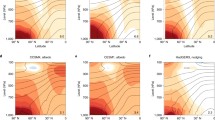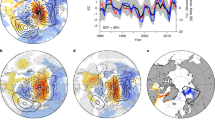Abstract
The ongoing loss of Arctic sea-ice cover has implications for the wider climate system. The detection and importance of the atmospheric impacts of sea-ice loss depends, in part, on the relative magnitudes of the sea-ice forced change compared to natural atmospheric internal variability (AIV). This study analyses large ensembles of two independent atmospheric general circulation models in order to separate the forced response to historical Arctic sea-ice loss (1979–2009) from AIV, and to quantify signal-to-noise ratios. We also present results from a simulation with the sea-ice forcing roughly doubled in magnitude. In proximity to regions of sea-ice loss, we identify statistically significant near-surface atmospheric warming and precipitation increases, in autumn and winter in both models. In winter, both models exhibit a significant lowering of sea level pressure and geopotential height over the Arctic. All of these responses are broadly similar, but strengthened and/or more geographically extensive, when the sea-ice forcing is doubled in magnitude. Signal-to-noise ratios differ considerably between variables and locations. The temperature and precipitation responses are significantly easier to detect (higher signal-to-noise ratio) than the sea level pressure or geopotential height responses. Equally, the local response (i.e., in the vicinity of sea-ice loss) is easier to detect than the mid-latitude or upper-level responses. Based on our estimates of signal-to-noise, we conjecture that the local near-surface temperature and precipitation responses to past Arctic sea-ice loss exceed AIV and are detectable in observed records, but that the potential atmospheric circulation, upper-level and remote responses may be partially or wholly masked by AIV.









Similar content being viewed by others
References
Adler SG et al (2003) The version 2 global precipitation climatology (GPCP) monthly precipitation analysis (1979-present). J Hydrometeor 4:1147–1167
Bi D, Dix M, Marsl SJ, O’Farrell S, Rashid H, Uotila P, Hirst AC, Kowalczyk E, Golebiewski M, Sullivan A, Yan H, Hannah N, Franklin C, Sun Z, Vohralik P, Watterson I, Zhou X, Fiedler R, Collier M, Ma Y, Noonan J, Stevens L, Uhe P, Zhu H, Griffies SM, Hill R, Harris C, Puri K (2013) The ACCESS coupled model: description, control climate and evaluation. Aust Met Oceanog J 63:9–32
Blüthgen J, Gerdes R, Werner M (2012) Atmospheric response to the extreme Arctic sea-ice conditions in 2007. Geophys Res Lett 39:L02707. doi:10.1029/2011GL050486
Cai D, Dameris M, Garny H, Runde T (2012) Implications of all season Arctic sea-ice anomalies on the stratosphere. Atmos Chem Phys 12:11819–11831
Collins W et al (2006) The formulation and atmospheric simulation of the community atmosphere model version 3 (CAM3). J Clim 19:2144–2161
Dee DP et al (2011) The ERA-interim reanalysis: configuration and performance of the data assimilation system. Q J R Meteorol Soc 137:553–597
Deser C, Tomas R, Alexander M, Lawrence D (2010) The seasonal atmospheric response to projected Arctic sea-ice loss in the late twenty-first century. J Clim 23:333–351
Deser C, Phillips A, Bourdette V, Teng H (2012) Uncertainty in climate change projections: the role of internal variability. Clim Dyn 38:527–546
Francis J, Vavrus S (2012) Evidence linking Arctic amplification to extreme weather in mid- latitudes. Geophys Res Lett 39:L06801. doi:10.1029/2012GL051000
Francis J, Chen W, Leathers D, Miller J, Veron D (2009) Winter northern hemisphere weather patterns remember summer Arctic sea-ice extent. Geophys Res Lett 36:L07503. doi:10.1029/2009GL037274
Ghatak D, Deser C, Frei A, Gong G, Phillips A, Robinson D, Stroeve J (2012) Simulated Siberian snow cover response to observed Arctic sea-ice loss, 1979–2008. J Geophys Res 117:D23108. doi:10.1029/2012JD018047
Higgins ME, Cassano JJ (2009) Impacts of reduced on winter Arctic atmospheric circulation, precipitation, and temperature. J Geophys Res 114:D16107. doi:10.1029/2009JD011884
Honda M, Inoue J, Yamane S (2009) Influence of low Arctic sea-ice minima on anomalously cold Eurasian winters. Geophys Res Lett 36:L08707. doi:10.1029/2008GL037079
Hopsch S, Cohen J, Dethloff K (2012) Analysis of a link between fall Arctic sea-ice concentration and atmospheric patterns in the following winter. Tellus 64A:18624. doi:10.3402/tellusa.v64i0.18624
Hurrell J, Hack J, Shea D, Caron J, Rosinski J (2008) A new sea surface temperature and sea-ice boundary dataset for the community atmosphere model. J Clim 21:5145–5153
Jaiser R, Dethloff K, Handorf D, Rinke A, Cohen J (2012) Impact of sea-ice cover changes on the northern hemisphere atmospheric winter circulation. Tellus 64A:11595. doi:10.3402/tellusa.v64i0.11595
Kay J, Holland M, Jahn A (2011) Inter-annual to multi-decadal Arctic sea ice extent trends in a warming world. Geophys Res Lett 38:L15708. doi:10.1029/2011GL048008
Liu J, Curry J, Wang H, Song M, Horton R (2012) Impact of declining Arctic sea-ice on winter snowfall. Proc Natl Acad Sci USA 109:4074–4079
Livina V, Lenton T (2013) A recent tipping point in Arctic sea-ice over: abrupt and persistent increase in the seasonal cycle since 2007. Cryosphere 7:275–286
Martin GM et al (2011) The HadGEM2 family of met office unified model climate configurations. Geosci Model Dev 4:723–757
Orsolini Y, Senan R, Benestad R, Melsom A (2012) Autumn atmospheric response to the 2007 low Arctic sea-ice extent in coupled ocean-atmosphere hindcasts. Clim Dyn 38:2437–2448
Overland J, Wang M (2010) Large-scale atmospheric circulation changes are associated with the recent loss of Arctic sea-ice. Tellus 62A:1–9
Parkinson CL, Comiso JC (2013) On the 2012 record low Arctic sea ice cover: combined impact of preconditioning and an August storm. Geophys Res Lett 40:1356–1361
Petoukhov V, Semenov V (2010) A link between reduced Barent-Kara sea-ice and cold winter extremes over northern continents. J Geophys Res 115:D21111. doi:10.1029/2009JD013568
Porter D, Cassano J, Serreze M (2012) Local and large-scale atmospheric responses to reduced Arctic sea-ice and ocean warming in the WRF model. J Geophys Res 117:D11115. doi:10.1029/2011JD016969
Screen JA, Simmonds I (2010a) The central role of diminishing sea ice in recent Arctic temperature amplification. Nature 464:1334–1337
Screen JA, Simmonds I (2010b) Increasing fall-winter energy loss from the Arctic Ocean and its role in Arctic temperature amplification. Geophys Res Lett 37:L16797. doi:10.1029/2010GL044136
Screen JA, Simmonds I (2012) Declining summer snowfall in the Arctic: causes, impacts and feedbacks. Clim Dyn 38:2243–2256
Screen JA, Simmonds I (2013a) Exploring links between Arctic amplification and mid-latitude weather. Geophys Res Lett 40:959–964
Screen JA, Simmonds I (2013b) Caution needed when linking weather extremes to amplified planetary waves. Proc Natl Acad Sci USA. doi:10.1073/pnas.1304867110
Screen JA, Deser C, Simmonds I (2012) Local and remote controls on observed Arctic warming. Geophys Res Lett 39:L10709. doi:10.1029/2012GL051598
Screen JA, Simmonds I, Deser C, Tomas R (2013) The atmospheric response to three decades of observed Arctic sea-ice loss. J Clim 26:1230–1248
Seierstad I, Bader J (2009) Impact of projected future Arctic sea-ice reduction on extratropical storminess and the NAO. Clim Dyn 33:937–943
Simmonds I, Rudeva I (2012) The great Arctic cyclone of August 2012. Geophys Res Lett 39:L23709. doi:10.1029/2012GL054259
Singarayer J, Bamber J, Valdes P (2006) Twenty-first-century climate impacts from a declining Arctic sea-ice cover. J Clim 19:1109–1125
Strey S, Chapman W, Walsh J (2010) The 2007 sea-ice minimum: impacts on the Northern Hemisphere atmosphere in late autumn and early winter. J Geophys Res 115:D23103. doi:10.1029/2009JD013294
Stroeve J, Serreze M, Holland M, Kay J, Maslanik J, Barrett A (2011) The Arctic’s rapidly shrinking sea-ice cover: a research synthesis. Clim Chang 110:1005–1027
Strong C, Magnusdottir G, Stern H (2010) Observed feedback between winter sea-ice and the North Atlantic oscillation. J Clim 22:6021–6032
Taschetto AS, England MH (2008) Estimating ensemble size requirements of AGCM simulations. Meteorol Atmos Phys 100:23–36
Terray L, Corre L, Cravatte S, Delcroix T, Reverdin G, Ribes A (2012) Near-surface salinity as nature’s rain gauge to detect human influence on the tropical water cycle. J Clim 25:958–977
Von Storch H, Zwiers FW (1999) Statistical analysis in climate research. Cambridge University Press, Cambridge
Wehner MF (2000) A method to aid in the determination of the sampling size of AGCM ensemble simulations. Clim Dyn 16:321–331
Wu Q, Zhang X (2010) Observed forcing-feedback processes between northern hemisphere atmospheric circulation and Arctic sea-ice coverage. J Geophys Res 115:D14199. doi:10.1029/2009JD013574
Xie P, Arkin PA (1997) Global precipitation: a 17-year monthly analysis based on gauge observations, satellite estimates, and numerical model outputs. Bull Am Meteorol Soc 78:2539–2558
Zhang J, Lindsay R, Schweiger A, Steele M (2013) The impact of an intense summer cyclone on 2012 Arctic sea-ice retreat. Geophys Res Lett. doi:10.1002/grl.50190
Acknowledgments
Laurent Terray is thanked for useful discussions on the statistical methods. Two anonymous reviewers are thanked for the constructive comments. Parts of this research were funded by the Australian Research Council, the Merit Allocation Scheme on the Australian National Computational Infrastructure, the US National Science Foundation (NSF) Office of Polar Programs, and the UK Natural Environment Research Council grant NE/J019585/1. NCAR is sponsored by the NSF.
Author information
Authors and Affiliations
Corresponding author
Rights and permissions
About this article
Cite this article
Screen, J.A., Deser, C., Simmonds, I. et al. Atmospheric impacts of Arctic sea-ice loss, 1979–2009: separating forced change from atmospheric internal variability. Clim Dyn 43, 333–344 (2014). https://doi.org/10.1007/s00382-013-1830-9
Received:
Accepted:
Published:
Issue Date:
DOI: https://doi.org/10.1007/s00382-013-1830-9




